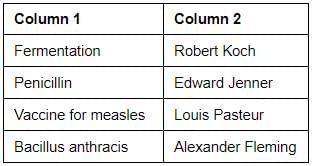Test: Class 8 General Science NCERT Based - 1 - UPSC MCQ
15 Questions MCQ Test Science & Technology for UPSC CSE - Test: Class 8 General Science NCERT Based - 1
In India, crops are classified into two groups, on the basis of the season they grow-Rabi crops and Kharif crops. In the context of these crops, consider the following statements:
1. Kharif crops are sown in summer.
2. Rabi crops are grown in winter.
Which of the statements given above is/are correct?
With regard to organic manure, consider the following statements:
1. It enhances the water holding capacity of the soil.
2. It makes the soil loose and porous.
3. It enhances the number of friendly microbes.
Which of the statements given above is/are correct?
Cod liver oil contains a high amount of vitamin D. From which of the following animals, is cod liver oil obtained?
Which one of the following is a preservative used in preservation of fruits as jams and jellies?
Beans and peas are preferably grown in nitrogen deficient soil because:
1. They absorb most of the nitrogen from the soil.
2. They are leguminous plants.
3. They have rhizobium in root nodules which can fix atmospheric nitrogen.
4. They are green plants.
Which one of the following crops does not require nitrogenous fertiliser?
Which one of the following pairs is incorrect?
Aspergillosis - Fungi.
The process of loosening and turning the soil is called:
Which one among the following is a useful microorganism?
1. Salmonella typhi
2. Rhizobium
3. Lactobacillus
4. Rhinovirus
Which leaves are used to protect stored grains from insects and microorganisms?
Consider the following statements in the context of microorganisms and diseases caused by them:
1. Chicken pox and Hepatitis A are caused by viruses.
2. Typhoid and Measles are caused by bacteria.
3. Diarrhoea and Malaria are caused by protozoa.
Which of the statements given above is/are correct?
Consider the following:
1. Algae: Spirogyra
2. Protozoa: Chlamydomonas
3. Fungi: Rhizopus (bread mould)
Which of the pairs given above is/are correctly matched?
Which of the following microorganisms is required to turn milk into curd?
Which of the following is produced by yeast through respiration, when it is mixed with food items?
Match the items in Column 1 with those in Column 2, and choose the correct option.


|
114 videos|428 docs|209 tests
|



















